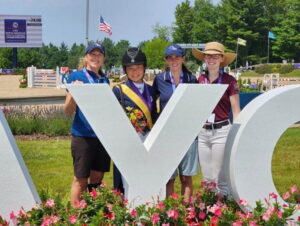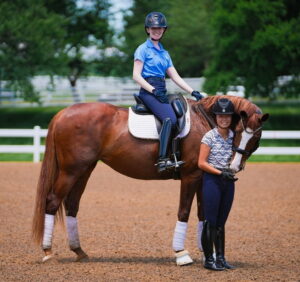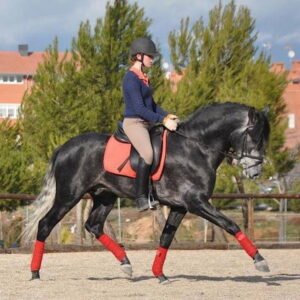Trainer/rider Nicole DelGiorno is concerned about why more children and young people aren’t riding dressage in the U.S., even as the hunter/jumper/hunt seat equitation ranks are crammed with kids.
A four-time North American Youth Championships medalist and board member of the Dressage Foundation, Dressage4Kids and Dressage at Devon, she began her learning process with the U.S. Pony Club. Nicole, whose specialty involves developing youth riders and young professionals, is a U.S. Dressage Federation Bronze, Silver and Gold medalist. She also has served as chef d’equipe for Children’s and Junior teams.
She took to social media to diagnose the problem, airing her thoughts on why more U.S. kids aren’t riding dressage. It goes without saying that it is important to have young people coming up through the pipeline so eventually they can represent their country at championships, such as the Olympics. The grassroots are key.
“My goal is to start the conversation,” Nicole told me. While some people do discuss the subject, she believes “it’s a matter of everyone coming together deciding what the right course of action is.” She mentioned that without reinventing the wheel, “There are so many great examples,” to provide inspiration, such as what the American Quarter Horse Association does for its kids.
While some USDF GMO’s (Group Member Organizations) offer age-appropriate schooling show competitions, Nicole noted that is “really dependent on your local GMO and how active and creative they are.” One bright spot in USDF’s Region 1 ((Delaware, Maryland, New Jersey, North Carolina, Pennsylvania, and Virginia) is Lendon Gray’s Youth Festival for riders 25 and under, to be held Aug. 8-10 at the Horse Park of New Jersey. The only other similar festival, according to Nicole, is in Georgia.
Nicole, who is based in New Jersey, offers some intriguing insights. She contends “the recognized youth divisions in U.S. dressage are structured terribly, and that is definitively why we cannot get more kids in dressage.”

Nicole with her former student and current assistant, Quinn Ridgway, at the North American Youth Championships with Quinn’s family.
She illustrated the situation with this theoretical example:
“You are a non-horse parent with a 6-year-old kid that loves horses. You type `horseback riding lessons near me’ into a search engine and start investigating. Ninety percent of the programs that show up offer instruction in hunt seat equitation. Must be popular! You see that the highest-rated barn offers a summer camp and you decide to send your child. She loves it and starts making friends with the kids who ride at the barn. She begs for weekly riding lessons. She takes lessons one to two days a week until her trainer mentions that she is really getting quite good. She should start to compete.
“She does the leadline division and gets exposed to an environment like the Devon Horse Show. Dreams ablaze in her heart, she asks if she can have a pony of her own, but your family isn’t ready for that type of commitment.
`No worries,’ says the trainer. `You can lease our small pony.’ Then she ages out and you lease the medium pony…or the large pony… or the junior hunter.
“But at some point, your kid is getting quite good and the trainer helps you buy a competitive A-circuit equitation horse. Your daughter goes on to place well at several big championships, catching the attention of a noted trainer who offers to take her on as a rider. She goes on to become an assistant trainer, or to cruise happily around the amateur divisions. The End.”
Nicole observed that storyline involves, “Everything curated. Everything clear. Their goal is to not overwhelm parents, because there is real money in developing youth riders in hunter/jumper land and real milestones to attain from the time the kids are little. When that’s true, the trainers are happy and structure their programs to make parents and children happy.
“Now, let’s say your first call was to a dressage barn,” Nicole continued.
“Nine times out of ten, that conversation is going to go like this: `Hello! I am inquiring about riding lessons for my 6-year-old daughter.’ ….`Hi! Does she have her own horse?’ …`No, we don’t.’ `Sorry, can’t help you.’”
Nicole goes on to illustrate another scenario, in which the parent calls one of the 10 percent of dressage barns that can accommodate beginner children.
“Your kid takes riding lessons there for two years. In her third year, she might do some dressage schooling shows at Introductory Level. Your trainer may even take her to some unrated hunter/jumper shows because the format is easier, cheaper and she can get more ring time. Next year, your kid begs to show recognized at Training Level. At only 10 years old, she really does quite well on the barn’s lesson pony. She qualifies for Regional Championships.
Continuing, Nicole suggested, “When you arrive in the warmup for your first class, you see your child’s eyes widen to saucers. She rides over to her trainer and asks in hushed tones, `Is SHE in my class?’
`Yes, my dear, SHE is.’ Your eyes slide over to the 21-year-old rising professional riding her client’s young horse, who appears to be the second coming of Glamourdale. The class commences. Your kid rides her heart out on her lesson pony (you had tried to find something nice for her to lease for this year, but no luck finding a quality seasoned dressage pony for lease). Still, even with her best test of the year, she places third to last with a 62 percent. The young pro wins with a 74 percent. Not because your kid isn’t great and skilled for her age, but because there is a chasm in terms of experience and physical ability between a 10-year-old and a 21-year-old.

Nicole DelGiorno with her former student Quinn Ridgway, who is now her assistant. (Photo by Priceless Equine Productions)
“This is what it is going to look like for the next few years until you buck up and buy a pony for her to do FEI Children’s or Ponies (probably from Europe, because that’s the only place to reliably find a competitive pony that’s actually been shown and proven by a kid). Sure, you could aim at Dressage Seat Equitation Medal Finals, which has a 13 and under division… if you have one of the few 10-year-olds who can ride First Level inside out and backwards, and you can find a size-appropriate mount for her to do it on.”’
She suggested splitting Youth Division classes at Second Level and below according to the rider’s age, noting it wouldn’t cost more than few extra sets of ribbons.
For Dressage Seat Equitation, her idea is a Walk-Trot Equitation class aimed at beginner riders with an Introductory skill set; Walk-Trot-Canter aimed at novice riders with a Training Level skill set and then Advanced Equitation.
It “would keep the current standards for riders with a First Level skill set and feed into the Dressage Seat Medal Finals.” Nicole also would like to see a Pony Division split according to size.
To read more of her suggestions, click here.
The problem, as Nicole sees it, is that “In general, we do NOT provide the Disney experience to families like the hunter/jumper community does. We do not structure our divisions to give kids appropriate milestones (Why not have an equitation class that is just Walk/Trot like they do in hunter/jumper land? Why can’t we get out of our own way and reward correct basics without making the kids do leg yield, zig-zags and counter-canter and three changes of lead through trot on the diagonal?)
“Because the way our youth divisions are structured is so challenging, no trainer really wants to structure their business around it. It’s a bad gamble that will almost assuredly result in a ticked-off parent and a disappointed kid. Much easier to help adult amateurs…pursue their medals.”
She emphasizes what is at stake for the discipline: “We want to see more kids riding dressage. We want to see better horsemanship and depth at every level of the sport. Then where is the space for younger riders to compete, learn and connect with their peers? Where are the milestones for them to aim toward?”
Nicole feels it’s crucial to address these issues, mentioning the concept of a USDF task force that could examine the subject and come up with ideas.
“Until we have an outlet for these young kids to showcase their skill and test their ability in classes that are structured fairly, I think we are going to continue scratching our heads and wondering, `Where are the dressage kids?’ ”
Anyone who thinks they have answers and wants to continue the conversation Nicole started may contact her at nicole.delgiorno@gmail.com.

